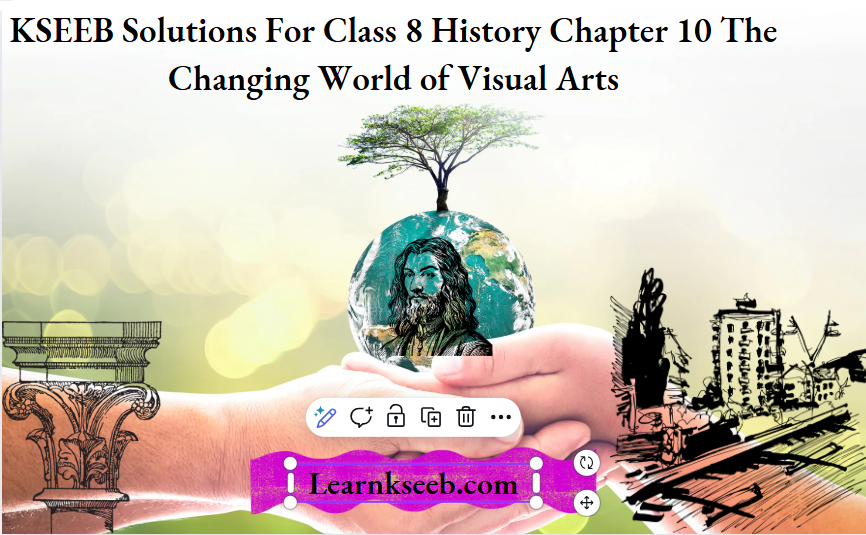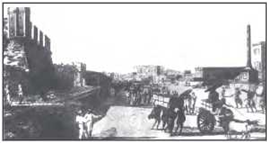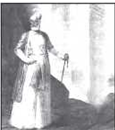KSEEB Solutions for Class 8 History Chapter 10 The Changing World of Visual Arts Textbook Questions
Question 1 Fill in the blanks:
(a)The art form that observed carefully and tried to capture what the eye saw is called
(b)The style of painting which showed Indian landscape as a quaint, unexplored land is called
(c)Paintings that showed the social lives of Europeans in India are called____________
(d)Paintings which depicted scenes from British imperial history and their victories are called
Answer.
(a) Realism
(b) Picturesque
(c) Portraits
(d) History paintings
Question 2. Point out which of the following were brought in with British art:
(a) oil painting
(b) miniatures
(c) life-size portrait painting
(d) use of perspective
(e) mural art
Answer.
(a) oil painting Yes
(b) miniatures No
(c) life-size portrait painting Yes
(d) use of perspective No
(e) mural art No

Kseeb Class 8 History Chapter 10 The Changing World Of Visual Arts Solutions Pdf
Question 3 Describe in /our own words one painting from this chapter which suggests that the British were more powerful than Indians. How does the artist depict this?
Answer.

- This history painting was made by Francis Hayman in 1762. In this picture, Lord Clive is shown meeting Mir Jafar, the Navvab of Murshidabad, after the Battle of Plassey. The Britsh had defeated Siraj-up-Beulah in the famous Battle of Plassey and put Mir Jafar in his place. The painting certainly shows the British more powerful than the Indian rulers.
- Mir Jafar is shown pleasing Lord Clive which means that Mir Jafar was just a puppet in the hands of the British.
Question 4 Why did the scroll painters and potters come to Kalighat? Why did they begin to paint new themes?
Answer The scroll painters and potters left their villages to come to Kalighat in early 19th century. At this time, new cities were emerging and expanding. There were several opportunities in the cities and the artists thought it best to sell and propagate their art there.
Earlier, the Kalighat painters cheated the images of mythological deities. Later, after 1840s they began to depict the culture and society around
Question 5 Why can we think of Raja Ravi Varma’s paintings as national?
Answer. Raja Ravi Varma attained mastery over the Western style of oil painting and the technique of realistic life study. He used these techniques to paint stories from Indian epics and portraits of Indian divinities. He also organised a unit for picture production. Religious paintings were produced on a large scale in the press which he established. They did not cost much. Thus, we can say that his paintings and creations were national.
Sslc Class 8 History The Changing World Of Visual Arts Question And Answers
Question 6 In what way did the British history paintings in India reflect the attitudes of imperial conquerors?
Answer. Many European painters depicted British victory over local rulers. The British were shown as powerful and victorious while the Indians were shown to be submissive and dutiful. In a famous painting created by Francis Hayman, Mir Jafar is shown as accepting the supremacy of British authority in front of Lord Clive. Another painting by David Wilkie shows Tipu Sultan being defeated by British generals.
Question 7 Why do you think some artists wanted to develop a national style of art?
Answer. Some artists saw Ravi Varma’s paintings as imitative of the Western style. They believed that Indians should develop their own forms and take inspiration from non-Western traditions. They revived the ancient style of mural paintings and medieval miniature paintings in their creations.
Question 8 Why did some artists produce cheap popular prints? What influence would such prints have had on the minds of people who looked at them?
Answer. Some artists like Raja Ravi Varma established printing presses and production units to reproduce colored reprints of their paintings. Through creating cheap prints, the Indian art spread among the masses. These popular prints were influential in spreading the message of nationalism and inspiring the people.
Class 8 History KSEEB The Changing World Of Visual Arts Notes
The Changing World of Visual Arts Additional Questions (Solved)
Very Short Answer Type Questions
Question 1 Give examples of art forms introduced by the British in India.
Answer. Domes, arches, and columns in buildings, scenic landscapes, portraiture, mechanical printing, and mass production of pictures are some forms of art introduced by the British in India.
Question 2 What was the picturesque landscape art?
Answer. It was a style of painting that showed the landscape as it is, in its wild and uneven form.
Question 3 What is meant by engraving?
Answer. Engraving refers to the technique of cutting or carving into wood, metal, or stone to form a design or pattern.
Question 4 Name a few painters of picturesque art.
Answer. Thomas Daniell and his nephew, William Daniell were some famous artists of the s type of landscape painting.
Question 5 What is a portrait?
Answer. A portrait refers to a picture in which the face and the expressions of any person stand out
Question 6 Why did the portrait painters come to India:
Answer The portrait paintings were extremely popular in that age. Many European painters came to India because they could De be commissioned by local r\jlers, princes and nobles to make their portraits.
Kseeb Class 8 History The Changing World Of Visual Arts Textbook Solutions
Question 7 What was history painting?
Answer. History painting was a popular art form in the 18th and 19th centuries. The artists recreated important episodes and events in history
Question 8 How did Tipu Sultan encourage local traditions?
Answer. Tipu Sultan resisted the foreign elements of the British culture. He encouraged the local artists and their works. His palace at Seringapatam was decorated with local mural paintings.
Question 9 How did the Murshidabad Court encourage art?
Answer. The local miniature artists were instructed by the Court to imbibe styles preferences and modes of the British.
Question 10 Why did the local artists seek support from the British?
Answer. A number of Indian artists lost their patronage from local kings and nobles whose authority was ended by the British. Therefore, they sought to seek support and encouragement from the British.
Question 11 What were the Company paintings?
Answer. The British officials eagerly collected paintings which depicted Indian life. These paintings were known as Company paintings.
Question 12 Who were the scroll painters?
Answer. Scroll painters drew their art on long sheets of paper, which could be rolled up. Their themes differed from mythology to social and cultural life.
Question 13 What was life study?
Answer. Life study was the study of human figures from living models who posed for the artists.
Question 14 When was the Central Post Office in Calcutta built?
Answer. The Central Post Office was built in Calcutta in the 1860s. The Changing World of Visual Arts
KSEEB Class 8 History solutions For The Changing World Of Visual Arts
Short Answer Type Questions
Question 1 What did the European artists introduce in India?
Answer.
- The idea of realism in art was introduced by the Europeans. The artist had to observe closely and recreate what he actually saw.
- The technique of oil painting was brought to India by the Europeans. Oil paintings looked very alive and real.
Question 2 What did the paintings of Thomas Daniell and William Daniell depict?
Answer
- In most of their picturesque landscapes, they showed ruins of the old structures. It was portrayed that the Indian civilisation was in decay.
- Their paintings of modern cities showed the signs of development and prosperity brought by the British rule in India. There was movement, activity’’ and enthusiasm on the roads arid streets.
- Their paintings served the British purpose of showing that colonial rule was needed to uplift and modernise India.
Question 3 What were the main features of portrait painting?
Answer. The Indian style of making portraits mainly existed in the form of miniature paintings. On the other hand, the colonial portraits were huge in size and seemed very real. The DO’traits depicted the influence and authority of their patrons. They were made to show’ rich status and lavish lifestyles through paintings.
Question 4 Discuss the paintings of Johann Zoffany.
Answer. Johann Zoffany painted many pictures of large colonial bungalows. The British took prominence in his paintings who were shown wearing exquisite clothes and living luxurious lives. The Indians were shown as inferior beings always sewing their British masters.
Question 5 What was the reaction of Indian nawabs towards the British Residents posted in their courts?
Answer. The British posted their Residents or representatives in the courts of the rulers who became loyal to the British and accepted their authority. These Residents soon began to control the state affairs, diminishing the power of the rulers. Some local rulers resisted this interference, while others readily accepted the superiority of the British. They often embraced the British way of life.
The Changing World Of Visual Arts Class 8 History Kseeb Important Questions
Question 6 Who was Nawab Muhammad Ali Khan?
Answer. Muhammad Ali Khan was the Nawab of Arcot He fought against the British in the 1770s but was defeated. Then he became a regular pensioner of the English East India Company. He appointed two European artists, George Willison and Tilly Kettle to make his own portraits. These paintings were gifted to British monarchy and Directors of the Company. Although he had no real political power, his paintings depicted him as a strong ruler.
Question 7 What were the main features of scroll paintings?
Answer.
- The Kalighat Temple was a famous center of pilgrimage. Many local painters from villages migrated to Kalighat They were mainly scrolling painters.
- The scroll painters made the images of gods and goddesses. These figures generally looked flat, and not rounded.
- The scroll painters adopted different techniques like shading to make the images look three-dimensional. The images looked bold and unreal with minimum use of lines, color, and detail.
- With the changing times, the Kalighat painters represented social and political life. Through their art, they ridiculed the social ills and adoption of British manners besides portraying the lives of the poor.
Question 8 Why did Abanindranath Tagore reject the art of Raja Ravi Varma?
Answer. Abanindranath Tagore was the nephew’ of Rabindranath Tagore. He criticised the art of Raja Ravi Varma because it somewhat imitated Western techniques. He held the view that Indian art should free itself from Western influences. The Indian artists should develop their own forms of art The Western styles should not be used to depict ancient Indian mythology.
The Changing World Of Visual Arts Class 8 KSEEB Questions And Answers
The Changing World of Visual Arts Long Answer Type Questions
Question 1 Discuss the various forms of imperial art.
Answer. Some forms of imperial art are described as follows:
- Landscapes: This picturesque style of painting depicted the landscape in its natural form. It showed Ind a as a strange land, which should be explored by the British. The oil paintings made by Thomas and William Daniell are some examples.
- Portraits: It was another style of painting that became very popular in colonial India. The wealthy and the influential wanted to make their life-size portraits. It showed their lavish lifestyle, high status and elegant clothing. Both the British and the Indians commissioned artists to make portraits.
- History painting: Another category of imperial art was history painting. This tradition of painting recreated different scenes of British imperial history. This style gained popularity in late 18th and early 19th centuries. The British conquests in India were a repeated theme in such paintings.
Question 2 Give a brief description of Raja Ravi Varma.
Answer. Raja Ravi Varma was one of the first Indian artists who innovated a style of painting that was both national and modern, l-le belonged to the royal family of Travancore. Raja Ravi Varma acquired expertise in the Western art of oil painting and real-life study. He drew inspiration from the dramatic performances of the Indian mythological stories. He painted those scenes vividly on the canvas. His works became popular with the Indian ruling classes and appreciators of art After gaining popularity, he established a printing press and a production unit near Bombay. His paintings were reproduced and reprinted in large numbers, which were sold at cheap prices among the masses.
The Changing World of Visual Arts Hots Corner
Question 1 Why did Raja Ravi Varma set up a printing unit and a picture production team in Bombay?
Answer Raja Ravi Varma established a printing press to make reprints and reproductions of his own paintings. These reprints could be distributed among the masses at low prices and popularise Indian art forms.
Question 2 Why did the new generation of artists deviate from the tradition of Abanindranath Tagore?
Answer. After the 1920s, many artists moved away from the style of painting made popular by Abanindranath Tagore. They argued that religion and spirituality should not dominate Indian art They stood for depiction of real life in the paintings with inspiration from folk and tribal art. Thus, new styles and movements in art began to develop afterward.
The Changing World of Visual Arts Miscellaneous Questions
A.Multiple Choice Questions Tick the correct option from the choices provided:
Question 1 An accepted norm or style is called a/an___________
(a) Convention
(b) Commission
(c) Engraving
(d) Mural
Answer. (a) Convention
Question 2 The art form which requires close observation and exact recreation is called____________
(a) Realism
(b) Picturesque
(c) Portrait
(d) History painting
Answer. (a) Realism
Question 3 The style of painting which showed Indian landscape as a strange and unexplored land is known as___________
(a) Portrait
(b) Picturesque
(c) Realism
(d) History painting
Answer. (b) Picturesque
Karnataka Sslc Class 8 History Chapter 10 Solutions In English
Question 4 Paintings that showed the social lives of Europeans in India are called_________
(a) Murals
(b) History paintings
(c) Portraits
(d) Picturesque landscapes
Answer. (c) Portraits
Question 5 ___________are the paintings which depicted scenes from British imperial history and their victories.
(a) Landscapes
(b) Realistic paintings
(c) Portraits
(d) History paintings
Answer. (d) History paintings
Question 6 Which of these was brought in India by the British?
(a) Oil painting
(b) Miniatures
(c) Use of perspective
(d) Mural art
Answer. (a) Oil painting
Question 7 Who wanted to develop a national style of art?
(a) Raja Ravi Varma
(b) Rabindrarath Tagore
(c) Abanindranath Tagore
(d) Francis Hayman
Answer. (c) Abanindranath Tagore
Question 8 Who decided to set up a picture production team and printing press in Bombay?
(a) Raja Ravi Verma
(b) Rabindranath Tagore
(c) Abanindranath Tagore
(d) Francis Hayman
Answer. (a) Raja Ravi Verma
Kseeb Class 8 History The Changing World Of Visual Arts Solved Exercises
The Changing World of Visual Arts B.True or False
State whether the following statements are true or false:
1 European artist came to India along with the British traders.
Answer. True
2 Engraving is a picture printed on a paper from a piece of wood or metal into which the design is cut into.
Answer. True
3 A picture of a person in which the face and its expression is highlighted is called a portrait.
Answer. True
4 Johann Zoffany came to India in mid-1780s for five years.
Answer. True
5 Scroll painters were encouraged by the Murshidabad Court.
Answer. False
6 Victoria Terminus was built between 1878 and 1887.
Answer. True
The Changing World of Visual Arts C.Picture Interpretation
Question 1 Study the given picture carefully and answer the following questions:

1 Who painted this picture?
2 What does this painting portray?
Answer.
1.It was painted by Thomas Daniell and William Daniell in 1786 who were famous for their picturesque art
2.The painting shows the Clive Street in Calcutta. It shows advancement and development brought about by the British in the Indian towns. The European buildings, wide streets, new means of transport and fast-moving life are prominent features of this painting.
Question 2 Study the given picture and answer the following questions:

1 Name the person shown in the given picture.
2 Tell something about the person shown in the picture.
Answer.
1. The picture shows Muhammad Ali Khan.
2. Muhammad Ali Khan was the Nawab of Arcot. He fought against the British in the 1770s but was ultimately defeated. Afterward, he submitted his loyalty to the British and became a pensioner of the Company. He commissioned European artists to make his portraits. He gifted those portraits to the British Crown and the Company Directors.
The paintings depicted the Nawab as a strong ruler even though he had no real power.
